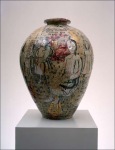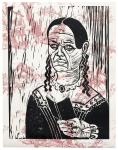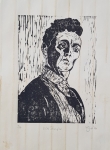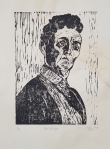This page is split in to 3 sections, research, practical & conclusion
Who to study?
The course directs me to carry out a detailed study of a printmaker of my choice as a Parallel Project. Printmaker Eileen Cooper (RA OBE) is a significant figure in contemporary art and I initially determined to look at her vast body but during research of Cooper plus other artists such as Robert Rauschenberg & Prunella Clough I’ve also been increasingly aware of narrative & how its used in today’s artistic representation. Cooper brings much narrative to her work, which is perhaps why I’m so drawn to her prints & paintings, however the more I research her & other artists the more I realise I’m interested in a bigger picture, how key social issues are addressed and interpreted on a broader platform than the one Cooper chooses to portray. I feel connected to art that tells a bigger story to make a statement & Grayson Perry fits this perfectly. His work is contemporary, controversial and addresses conflicting and sensitive issues which I’m drawn back to it time and time again, interpreting his pots, tapestries, prints or other medium in varying ways, so it will be him and his use of narrative that I’ll be looking at in depth.
SYNOPSIS ESSAY – GRAYSON PERRY
I’m directed to carry out a detailed study of a printmaker throughout the length of this course. Having seriously considered both Eileen Cooper & Robert Rauschenberg I’ve chosen to look in depth at the work of artist Grayson Perry.
His list of accomplishments is extensive, including a Turner Prize win in 2003, speaker of the 2013 Reith Lectures, winner of two BAFTA awards. More recently he curated the 2018 Summer Exhibition at the Royal Academy of Arts and he’s had several books published. He’s made numerous television appearances & his achievements have earnt him UK household notoriety although within the art world he’s remains known predominantly for his large-scale ceramic pots, packed with incongruous juxtapositions and polemic with ideology. And then there’s his alter ego Claire Perry, plus veneration of the God that is Alan Measles, aka. his teddy-bear.
I’m interested in the way Perry uses his creative practice to tackle universally human subjects, from sexuality to religion and beyond. His work has been autobiographical, political and largely remains a true visual record of modern society, he’s opinionated both verbally and creatively and his work encourages dialogue, questions and deliberation. It’s equally fascinating to think of Perry as a printmaker, not a synonymous connection until I saw examples of his etchings, linoprints, woodcuts and others, made extensively throughout his career. His etching ‘Map of Nowhere’ (see Fig. 1.) being a prime example. But more broadly I’m especially interested in the way narrative dominates his outcomes chronicling contemporary life.
An article on Artsy.net in 2012 suggests that narrative has become a dirty word, that it is almost obsolete in contemporary art, calling it indulgent and unintelligent and not in keeping with the visual language contemporary artists seem to be obsessed by (Forrest 2012). The article goes on to say there is a slow revival taking place and it’s sparked my interest to take a closer look at progress, if any, some 6 years after this article was written. To contextualise this investigation I will look at who Perry is, from Claire and his transvestism through to how he’s viewed both in and from outside the art world. I’ll debate whether narrative in art is making a slow revival or not and if it is then in what forms can this be seen. I’ll begin by asking questions such as what happened to narrative in art since its decline in the Victorian period, why did it fall out of favour & does its resurgence have a future in our modern society. I propose to consider these, plus many other questions as they arise.
Resources & References
Artnet (s.d) Grayson Perry. At: http://www.artnet.com/artists/grayson-perry/ (Accessed on 31.01.19)
Forrest, N. (2012) A Revival of the Narrative in Contemporary Art. At: https://www.artsy.net/article/artmarket-a-revival-of-the-narrative-in-contemporary (Accessed on 27.12.18)
Saatchi Gallery (s.d) Grayson Perry. At: https://www.saatchigallery.com/artists/grayson_perry.htm (accessed 15.01.19)
The Guardian (2006) ‘I was thinking what fun it would be to label everybody socially.’ In: The Guardian [online] At: https://www.theguardian.com/uk/2006/mar/31/arts.artsnews (Accessed on 31.01.19)
Tate (s.d) Grayson Perry – Winner. At: https://www.tate.org.uk/whats-on/tate-britain/exhibition/turner-prize-2003/turner-prize-2003-artists-grayson-perry (Accessed on 31.01.19)
Victoria Miro (s.d) Grayson Perry. At: https://www.victoria-miro.com/artists/12-grayson-perry/ (Accessed on 31/01/2019)
Illustrations
Figure 1. Perry, G (2008) Map of Nowhere [etching] At: http://paragonpress.co.uk/works/map-of-nowhere (Accessed 31/01/19)
(Synopsis submitted with Part 2, Feb 2019)
research- GRAYSON PERRY (Visual Artist)
Initial thoughts:
I’ve been reading books written by Perry and some about him as well as researching online & watching DVD’s & YouTube interviews and I’m beginning to get a feel for the person that is Grayson Perry. Its time now to think further about my own objectives for this parallel project, how I can begin to break those down in a practical way, to start working my ideas in to my sketchbook and the glimmerings of a way forward in this investigation.
- What do I want to achieve from this project?
- How might I foresee my research physically culminating in Project 6? A large multi-block print? A book? A scroll? More than one result?
- What influences might this project have on my own practice?
I’ll ask a lot more questions as I go along so I’ll be adding to this list, but in the meantime I’m going to concentrate on the first question ‘What do I want to achieve from this project’. To answer that I need to look at why I wanted to study this artist in the first place.
I’m intrigued with the way Perry uses his creative outlets to tell stories about himself, especially in his early career, how he explored events in his life both physically & psychologically, examining his opinions & thoughts about his upbringing. The key point for me is how much I enjoy his visual story telling.
 I took a look at Perry’s prize winning Turner Pots online from 2003, collectively called Village of Penians 2001. What is a ‘penian’? A search online reveals it means ‘a fucker’ or ‘a loser’ (Urban Dictionary, 2013). So even just the title of the whole display indicates multiple statements contained within a fictitious collective. Basing his imagery around a religious symbol of the phallus, using it with vulgar humor and sarcasm, he weaves stories of the village inhabitants, questioning masculinity & religious beliefs whilst going someway toward trying to shock the viewer in to questioning commonly held beliefs. Other pots have names such as We’ve Found The Body Of Your Child, Boring Cool People which can be considered a real poke at modern society & through use of an erect penis (an explicit image & deemed illegal to publicly show in the UK) also with provocation.
I took a look at Perry’s prize winning Turner Pots online from 2003, collectively called Village of Penians 2001. What is a ‘penian’? A search online reveals it means ‘a fucker’ or ‘a loser’ (Urban Dictionary, 2013). So even just the title of the whole display indicates multiple statements contained within a fictitious collective. Basing his imagery around a religious symbol of the phallus, using it with vulgar humor and sarcasm, he weaves stories of the village inhabitants, questioning masculinity & religious beliefs whilst going someway toward trying to shock the viewer in to questioning commonly held beliefs. Other pots have names such as We’ve Found The Body Of Your Child, Boring Cool People which can be considered a real poke at modern society & through use of an erect penis (an explicit image & deemed illegal to publicly show in the UK) also with provocation.
The real delight for me about these pots is the story I’m consciously weaving & telling myself as I walk around each pot. Perry is vocal through each pots’ title about what he’s trying to tell you & the rest is left for my imagination to fill in. I’ve experienced a multitude of reactions to one of Perry’s pots from laughter to disgust to feelings of outrage & social righteousness to name a few at this early stage.
Bibliography
Badshah, N (2018) ‘Grayson Perry discloses details of estrangement from his mother.’ In: The Guardian [online] At: https://www.theguardian.com/artanddesign/2018/aug/14/grayson-perry-artist-discloses-details-of-estrangement-from-his-mother (Accessed on 07.02.19)
British Council (s.d) Village of Penians At: http://visualarts.britishcouncil.org/exhibitions/exhibition/private-utopia-contemporary-art-from-the-british-council-collection-2014/object/village-of-penians-perry-2001-p7486/objects/all/page/10 (Accessed on 07.02.19)
Grayson Perry and the Tomb of the Unknown Craftsman (2012) Directed by Neil Crombie [DVD] London: Simply Media
Hopkinson, S. (2014) Grayson Perry Interview: Map of Days At: https://www.artfund.org/news/2014/10/31/grayson-perry-interview-map-of-days (Accessed on 05.02.19)
Jones, W (2007) Grayson Perry. London: Vintage
Kenndy, M (2003) ‘Turner prize goes to Perry – and Claire’. In: The Guardian [online] At: https://www.theguardian.com/uk/2003/dec/08/arts.turnerprize2003 (Accessed on 07.02.19)
MMoCA (2014) Storybook: Narrative in Contemporary Art At: ARThttps://www.mmoca.org/exhibitions-collection/exhibits/storybook-narrative-contemporary-art (Accessed on 07.02.19)
Perry, G (2016) The Descent of Man. London: Penguin Books
Perry, G (2014) Playing to the Gallery. London: Penguin Books
Tate Britain (2003) The Turner Prize 2003 was awarded to Grayson Perry. The £20,000 prize was presented by the artist Sir Peter Blake At: https://www.tate.org.uk/whats-on/tate- britain/exhibition/turner-prize-2003 (Accessed on 07.02.19)
Urban Dictionary (2013) ‘Penian’ top definition [online] At: https://www.urbandictionary.com/define.php?term=Penian (Accessed 07.02.19)
Biography is the life history of an individual, written by someone else who’s researched that person, whereas the autobiography is an expression of a person’s life, written by that person.
Grayson Perry, whose etching Map of an Englishman (2004) uses 16th and 17th Century cartography techniques to explore the artist’s own mind.https://www.itsnicethat.com/news/grayson-perry-resilience-art-150817
Tutor Suggestion….
My tutor highlighted what I large topic it would be to cover narrative in art since the Victorian era & I think she might be right, at least in 2,000 words only. I’ve considered narrowing the research field & the suggestion to instead “focus on the theme of autobiography as a subject matter” seems more achievable & a suitable compromise.
Grayson Perry is a flamboyant man with a larger than life persona and keen interest in the social & political mechanics of daily life which he uses to weave stories. He uses similar themes across various different platforms, often using repetitive symbolic representations, such as Claire (his name for when he dresses up in women’s clothes) and his as teddy bear. He’s said his teddy bear, Alan Measles, is a perfect analogy of God, a mythical deity, projecting an emotional security from childhood imbuing this type of object with feelings & innocence. I can relate to this as I have a teddy bear which dates back over 40 years and which I was glued to for many of my younger childhood years. One other constant since childhood is a St Christopher pendant, the patron saint of travellers, of which I’ve now had several. For me, this symbol portrays a protector, someone to keep me safe in my travels, both physically and metaphorically.
Perry uses/includes/considers many of the following in his work:
- Domestic, religious, cultural infliction’s
- Transvestism
- Masculinity (from multiple perspectives)
- documenting contemporary life & society’s conflict, including political & religious subjects
- history
- idealised fantasy
- sensationalism shock & awe tactic
- humour
- nudity & sexuality
- storytelling
- descriptive titles
- symbols (special objects from religion are treated in much the same way as a revered piece of art)
- written words & buzz phrases, (getting over more than a picture can, to reiterate/explain)
- invitations to criticism, scepticism, intrigue and critique
- contradiction
- participation
- considerate of demographic audiences
- consideration of social class structures
practical interpretation
 Linoprints by Grayson Perry, Mr & Mrs Perry, 2005, printed on handmade paper, edition of 21 plus 3 artists proofs, each 52 x 38 cm.
Linoprints by Grayson Perry, Mr & Mrs Perry, 2005, printed on handmade paper, edition of 21 plus 3 artists proofs, each 52 x 38 cm.
These linoprints are GP’s response to American Primitive Folk Art. Nineteenth century amateur artists travelled America making rough portraits in a time before popularised photography. Their naiveté & often crude representations interested GP so he did portraits of himself & his wife Phillipa dressed as Victorians. He explains he used old wallpaper to mimic that time of poverty.
GP says himself,
‘I’m not a great portrait painter either – I’m happy to admit that. Mine weren’t intentionally bad though, they just came out pretty crude’
I’m drawn to the work of the group Die Brücke, their boldness feels passionate and Mr & Mrs Perry hold a similar draw. 
Left: Portrait of Heiliger Franziskus [St Francis] by Karl Schmidt-Rottluff Woodcut on paper 1919 image: 59.7 x 49.4
My print is based on the fascinating character Charlotte Stimple, played by Bronagh Gallagher, in the film The Guernsey Literary and Potato Peel Pie Society (2018) directed by Mike Newell. Mrs Stimple, is a fire & brimstone middle aged rather priggish women who reads the Bible but fails to reconcile their teachings with her judgemental preaching & malicious gossip about her neighbours.
Bronagh plays this character superbly & seeing Mr & Mrs Perry immediately reminded me of her. Although this print is simpler its been fun to make & I’ve realised that not all prints need to be complicated, either in design or technique, to be successful.
The print is technically very straight forward but strangely feels a move away from the work I’ve done recently. This may be because I’ve concentrated much more on depth & width of cut, deliberately creating variance across the plane, thought about the dramatic lighting of her face using chiaroscuro being conscious of the balance within the composition.
Resources
Klein, J. (Edition 2013) Grayson Perry. London: Thames & Hudson Ltd
0





